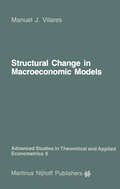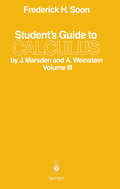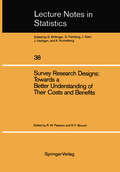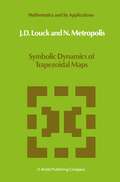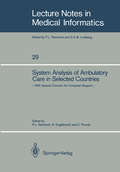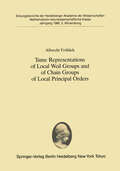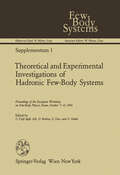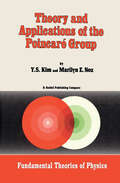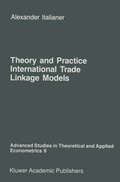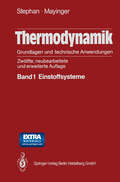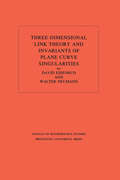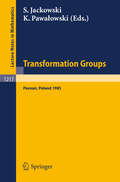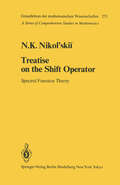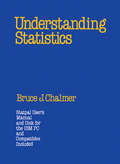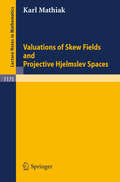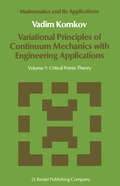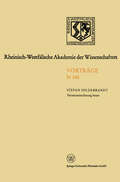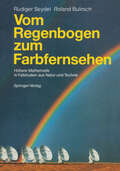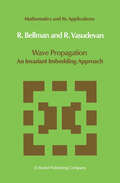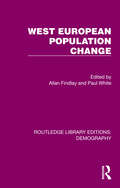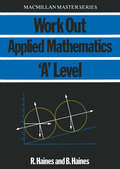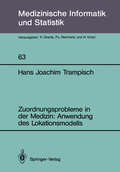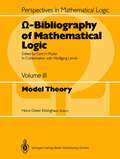- Table View
- List View
Structural Change in Macroeconomic Models: Theory and Estimation (Advanced Studies in Theoretical and Applied Econometrics #6)
by M.J. VilaresStudent’s Guide to Calculus by J. Marsden and A. Weinstein: Volume III
by Frederick H. SoonThis Student Guide is exceptional, maybe even unique, among such guides in that its author, Fred Soon, was actually a student user of the textbook during one of the years we were writing and debugging the book. (He was one of the best students that year, by the way. ) Because of his background, Fred has taken, in the Guide, the point of view of an experienced student tutor helping you to learn calculus. \~ile we do not always think Fred's jokes are as funny as he does, we appreciate his enthusiasm and his desire to enter into communication with his readers; since we nearly always agree with the mathe matical judgements he has made in explaining the material, we believe that this Guide can serve you as a valuable supplement to our text. To get maximum benefit from this Guide, you should begin by spending a few moments to acquaint yourself with its structure. Once you get started in the course, take advantage of the many opportunities which the text and Student Guide together provide for learning calculus in the only way that any mathe matical subject can truly be mastered - through attempting to solve problems on your own. As you read the text, try doing each example and exercise your self before reading the solution; do the same with the quiz problems provided by Fred.
Survey Research Designs: Prepared under the Auspices of the Working Group on the Comparative Evaluation of Longitudinal Surveys Social Science Research Council (Lecture Notes in Statistics #38)
by Robert W. Pearson Robert F. BoruchROBERT F. BORUCH AND ROBERT W. PEARSON During the 13th Century. a vigorous argument among Middle Eastern rabbis concerned how one ought to make a fair assessment of an olive crop value for tithing purposes. Should one consolidate the crop. systematically mix the olives. and then conscientiously draw a small random sample? Or. might one simply grab a handful of olives from the nearest basket and make an estimate of the crop's worth. The issue. of course. is one that research designers and research users confront often -- balancing the need for information against the resources that must be put into actually collecting the data -- in deciding how much effort is warranted to produce fair evidence. For the rabbis. who argued for twenty-five years over the matter. the issue can be resolved with a special rule. In this as in other cases. if the demand for information is biblical in origin -- if God is its source. then one ought to be considerably conscientious; a more scientific and more expensive endeavor is warranted. We may at times subscribe to this kind of rule of thumb in determining what quality of information is warranted under what conditions. But other rules and approaches are possible. And as medieval Jewish. Arabic. and Christian philosophy suggests. the alternatives need to be thought out and tested. Our interest is a bit more contemporary but has some spiritual kinship with early scholars' interest in empirical evidence.
Symbolic Dynamics of Trapezoidal Maps (Mathematics and Its Applications #27)
by J.D. Louck N. MetropolisIt isn't that they can't see the solution. It is Approach your problems from the right end and begin with the answers. Then one day, that they can't see the problem. perhaps you will find the final question. G. K. Chesterton. The Scandal of Father The Hermit Gad in Crane Feathers' in R. Brown The point of a Pin'. van GuIik's The Chinese Maze Murders. Growing speciaIization and diversification have brought a host of monographs and textbooks on increasingly specialized topics. However, the "tree" of knowledge of mathematics and related fields does not grow only by putting forth new branches. It also happens, quite often in fact, that branches which were thought to be completely disparate are suddenly seen to be related. Further, the kind and level of sophistication of mathematics applied in various sciences has changed drastically in recent years: measure theory is used (non trivially) in regional and theoretical economics; algebraic geometry interacts with physics; the Minkowsky lemma, coding theory and the structure of water meet one another in packing and covering theory; quantum fields, crystal defects and mathematical programming profit from homotopy theory; Lie algebras are relevant to filtering; and prediction and electrical engineering can use Stein spaces. And in addition to this there are such new emerging subdisciplines as "experimental mathematics", "CFD", "completely integrable systems", "chaos, synergetics and large-scale order", which are almost impossible to fit into the existing classification schemes. They draw upon widely different sections of mathematics.
System Analysis of Ambulatory Care in Selected Countries: With Special Concern for Computer Support (Lecture Notes in Medical Informatics #29)
by UrsulaPiccolo RolfEngelbrecht Peter L. ReichertzThe Working Group 5 of the International Medical Informatics Associa tion (IMIA) is dedicated to information systems in primary care with special emphasis on computer systems in the doctor's office. Accord ingly, a conference was held in Hannover in 1980 where the first ap proaches were described and experiences in system analysis, system construction and evaluation were discussed (Rienhoff, O. and Abrams, M.E. (eds.): The Computer in the Doctor's Office, North-Holland, Amsterdam: 1980). Computer hardware and software development has been rapid over the last years. Thus the prerequisites for a successful support of the work of the physician in his office have improved. But system con struction still lags behind and the actual penetration of systems is lower than 2 % of the doctors' offices in most countries. This applies to industrialized countries. However, attempts are made everywhere to improve primary care by means of modern information technology. Information systems depend upon the real environment into which they are placed: administrative procedures govern priorities and procedures in doctor's office computers, possibilities to defray cost upon the various carriers or the patients have a great influence on the propagation of systems. Furthermore, various procedures of accounting or re-imbursement may lead to a facilitation or to a delay of the in troduction of systems. The 'art of medical practice' has reached a comparable standard within at least the industrialized countries.
Tame Representations of Local Weil Groups and of Chain Groups of Local Principal Orders (Sitzungsberichte der Heidelberger Akademie der Wissenschaften #1986 / 3)
by Albrecht FröhlichWe begin by making clear the meaning of the term "tame". The higher ramifi cation groups, on the one hand, and the one-units of chain groups, on the other, are to lie in the kernels of the respective representations considered. We shall establish a very natural and very well behaved relationship between representa tions of the two groups mentioned in the title, with all the right properties, and in particular functorial under base change and essentially preserving root numbers. All this will be done in full generality for all principal orders. The formal setup for this also throws new light on the nature of Gauss sums and in particular leads to a canonical closed formula for tame Galois Gauss sums. In many ways the "tame" and the "wild" theory have distinct features and distinct points of interest. The "wild" theory is much harder and - as far as it goes at present - technically rather complicated. On the "tame" side, once we have developed a number of new ideas, we get a complete comprehensive theory, from which technical difficulties have disappeared, and which has a naturality, and perhaps elegance, which seems rather rare in this gen,eral area. Among the principal new concepts we are introducing are those of "similarity" of represen tations in both contexts and that of the Galois algebra of a principalorder., One might expect that this Galois algebra will ,also be of importance in the wild situation.
Theoretical and Experimental Investigations of Hadronic Few-Body Systems: Proceedings of the European Workshop on Few-Body Physics, Rome, October 7–11, 1986 (Few-Body Systems #1)
by Claudio Ciofi Degli Atti Omar Benhar Emanuele Pace Giovanni SalmeThis volume collects the papers given at the European Workshop "Theoretical and Experimental Investigations of Hadronic Few-Body Systems" which, adhering to an invitation of the European Few-Body Physics Research Committee, was organized in Rome on October 7-11, 1986. All papers presented at the workshop appear in the volume, plus two papers which could not be presented orally because their authors were at the last moment unable to attend. The list of contents closely follows the programme of the workshop. The workshop, attended by 128 American, European, and Japanese physicists from 60 different institutions and universities, was sponsored by the Italian National Institute for Nuclear Physics (lNFN) and was organized by the INFN Section located at the Istituto Superiore di Sanita (ISS), which kindly provided the venue for the meeting and many related facilities. The goal of the workshop was to summarize the present situa tion and the future perspectives concerning the theoretical descriptions of strongly interacting few-body systems and their experimental investigation by electromagnetic and hadronic probes, mainly at intermediate energies. To this end, representatives from most international groups working within different theoretical methods and with different experimental facilities, were invited and asked to illustrate their latest results and future research programs; the intention was to provide, by this way, an impartial and broad information which could be useful to whom is actively working in few body physics, as well as to young students entering this field of research.
Theory and Applications of the Poincaré Group (Fundamental Theories of Physics #17)
by Young Suh Kim M. NozSpecial relativity and quantum mechanics, formulated early in the twentieth century, are the two most important scientific languages and are likely to remain so for many years to come. In the 1920's, when quantum mechanics was developed, the most pressing theoretical problem was how to make it consistent with special relativity. In the 1980's, this is still the most pressing problem. The only difference is that the situation is more urgent now than before, because of the significant quantity of experimental data which need to be explained in terms of both quantum mechanics and special relativity. In unifying the concepts and algorithms of quantum mechanics and special relativity, it is important to realize that the underlying scientific language for both disciplines is that of group theory. The role of group theory in quantum mechanics is well known. The same is true for special relativity. Therefore, the most effective approach to the problem of unifying these two important theories is to develop a group theory which can accommodate both special relativity and quantum mechanics. As is well known, Eugene P. Wigner is one of the pioneers in developing group theoretical approaches to relativistic quantum mechanics. His 1939 paper on the inhomogeneous Lorentz group laid the foundation for this important research line. It is generally agreed that this paper was somewhat ahead of its time in 1939, and that contemporary physicists must continue to make real efforts to appreciate fully the content of this classic work.
Theory and Practice of International Trade Linkage Models (Advanced Studies in Theoretical and Applied Econometrics #9)
by A. ItalianerThis book was mainly written while I stayed at the Catholic University of Louvain. Professor Anton P. Barten was the one who did not only give me a warm welcome in Louvain, but also supported my research with most valuable comments and constructive criticisms. In addition I benefitted from dis cussions with Erik Schokkaert, Denis de Crombrugghe and Jo Baras on various subjects, such as the small-sample correction of Chapter 9. The arduous task of transferring my neat handwriting into a readable typescript was excellently taken care of by Brs. E. Crabbe and notably Brs. F. Duij sens, even after working hours. Mrs. A. Molders prevented me of making serious abuse of the English language. My admiration for Carien, finally, is an exponential function of the patience and enthusiasm with which she sup ported my research. Chapter I is a general introduction to the subject of linkage models, and it contains few mathematical elaborations. Chapters 2 to 4 use more, but elementary, mathematics, and treat several aspects related to the deriva tion, interpretation and estimation of linkage models. Chapter 2 deals vii tll the theory of import allocation models, Chapter J treats the problem of defining and interpreting elasticities of substitution, while Chapter 4 is concerned with the econometric problems related to the estimation of mul tivariate models with linear restrictions, such as import allocation models.
Thermodynamik. Grundlagen und technische Anwendungen: Band 1: Einstoffsysteme (Springer-Lehrbuch #1)
by Karl Stephan Franz MayingerDie zwölfte Auflage unterscheidet sich von den vorangegangenen durch eine umfassende Neubearbeitung. Trotz vieler Änderungen waren wir aber bemüht, Ziel und Anlage des Buches zu erhalten. Es soll als Lehrbuch der Thermodynamik den Studierenden, vor allem den der lngenieurwissenschaften, mit den Grundlagen der Thermodynamik und ihren technischen Anwendungen vertraut machen. Die im Vergleich zu anderen Lehrbüchern reichliche Ausstattung mit Zahlenangaben für Stoffeigenschaften, die sich schon in den früheren Auflagen bewährte, wurde weiter beibehalten. Dadurch wird die Lösung praktischer Aufgaben erleichtert, und dem Leser bleibt das oft mühsame Suchen von Stoffwerten erspart. Besonderer Wert wurde auf eine anschauliche und praxisorientierte Darstel lung des Stoffes gelegt. Dies sollte dem Studierenden die Anwendung des Ge lernten erleichtern und dem bereits in der Praxis Tätigen die technische Verwert barkeit klarer demonstrieren. Die Thermodynamik wird von den Studierenden im allgemeinen als eines der schwierigeren Wissensgebiete angesehen, obwohl sie mit nur wenigen Lehr sätzen, neuen Begriffen und mathematischen Kenntnissen auskommt. Dies mag vor allem an den Schwierigkeiten liegen, die wenigen, aber abstrakten Grund lagen auf konkrete technische und physikalische Vorgänge anzuwenden. Es war daher unser Bestreben, die Grundlagen trotz aller gebotenen wissenschaftlichen Strenge stets so anschaulich wie möglich darzubieten, und wir haben außerdem, wie in den früheren Auflagen, unmittelbar im Anschluß an entwickelte Sätze die damit schon behandelbaren Anwendungen angeschlossen. Zahlreiche Übungs aufgaben, deren Lösungen man im Anhang findet, sollen zu eigenem Rechnen anleiten und den Stoff vertiefen.
Three-Dimensional Link Theory and Invariants of Plane Curve Singularities. (AM-110), Volume 110
by David Eisenbud Walter D. NeumannThis book gives a new foundation for the theory of links in 3-space modeled on the modern developmentby Jaco, Shalen, Johannson, Thurston et al. of the theory of 3-manifolds. The basic construction is a method of obtaining any link by "splicing" links of the simplest kinds, namely those whose exteriors are Seifert fibered or hyperbolic. This approach to link theory is particularly attractive since most invariants of links are additive under splicing. Specially distinguished from this viewpoint is the class of links, none of whose splice components is hyperbolic. It includes all links constructed by cabling and connected sums, in particular all links of singularities of complex plane curves. One of the main contributions of this monograph is the calculation of invariants of these classes of links, such as the Alexander polynomials, monodromy, and Seifert forms.
Transformation Groups Poznan 1985: Proceedings of a Symposium held at Poznan, July 5-9, 1985 (Lecture Notes in Mathematics #1217)
by Stefan Jackowski Krzysztof PawalowskiTreatise on the Shift Operator: Spectral Function Theory (Grundlehren der mathematischen Wissenschaften #273)
by N.K. Nikol'skiiThis book is an elementary introduction to non-classical spectral theory. Mter the basic definitions and a reduction to the study of the functional model the discussion will be centered around the simplest variant of such a model which, formally speaking, comprises only the class of contraction operators with a one dimensional rank of non-unitarity (rank(I - T*T) = rank(I - TT*) = 1). The main emphasis is on the technical side of the subject, the book being mostly devoted to a development of the analytical machinery of spectral theory rather than to this discipline itself. The functional model of Sz. -Nagy and Foia§ re duces the study of general operators to an investigation of the . compression T=PSIK of the shift operator S, Sf = zf, onto coinvariant subspaces (i. e. subspaces in variant with respect to the adjoint shift S*). In the main body of the book (the "Lectures" in the proper meaning of the word) this operator acts on the Hardy space H2 and is itself a part of the operator of multiplication by the independent variable in the space L2 (in the case at hand L2 means L2(lf), If being the unit circle), this operator again being fundamental for classical spectral theory.
Understanding Statistics
by Bruce J. ChalmerIntroducing undergraduates to the vital concepts of statistics, this superb textbook allows instructors to include as much—or as little—mathematical detail as may be suitable for their students. Featuring Statpal statistical software for the IBM PC®, the book contains study questions that help solidify students’ understanding of the material and prepare them for the next group of concepts. Many of the exercises, labeled “Statpal exercises,” are especially written for the Statpal statistical package. Understanding Statistics begins with the basic concepts of statistical inference … presents normal and binomial distributions, general techniques of interval estimation and hypothesis testing, and applications of these techniques to inferences about a single population mean and proportions … and covers inferences about group differences, including parametric and nonparametric approaches to the two-group case, and the one-way ANOVA and its nonparametric analogue. In addition, this volume considers relationships between two variables, including the correlation co-efficient, Spearman’s rho, and Kendall’s tau ... surveys basic regression methods, including simple, multiple, and stepwise ... and discusses the analysis of variance of factorial designs, the concept of interaction, and the analysis of categorical data using the chi-square test. Complete with tables and drawings plus appendices that furnish instructions for using Statpal software, information on advanced topics, and much more, Understanding Statistics is an ideal text for undergraduate survey courses on statistical methods as well as for courses in economics, psychology, sociology, education, business administration, and others that require basic statistics.
Understanding Statistics
by Bruce J. ChalmerIntroducing undergraduates to the vital concepts of statistics, this superb textbook allows instructors to include as much—or as little—mathematical detail as may be suitable for their students. Featuring Statpal statistical software for the IBM PC®, the book contains study questions that help solidify students’ understanding of the material and prepare them for the next group of concepts. Many of the exercises, labeled “Statpal exercises,” are especially written for the Statpal statistical package. Understanding Statistics begins with the basic concepts of statistical inference … presents normal and binomial distributions, general techniques of interval estimation and hypothesis testing, and applications of these techniques to inferences about a single population mean and proportions … and covers inferences about group differences, including parametric and nonparametric approaches to the two-group case, and the one-way ANOVA and its nonparametric analogue. In addition, this volume considers relationships between two variables, including the correlation co-efficient, Spearman’s rho, and Kendall’s tau ... surveys basic regression methods, including simple, multiple, and stepwise ... and discusses the analysis of variance of factorial designs, the concept of interaction, and the analysis of categorical data using the chi-square test. Complete with tables and drawings plus appendices that furnish instructions for using Statpal software, information on advanced topics, and much more, Understanding Statistics is an ideal text for undergraduate survey courses on statistical methods as well as for courses in economics, psychology, sociology, education, business administration, and others that require basic statistics.
Valuations of Skew Fields and Projective Hjelmslev Spaces (Lecture Notes in Mathematics #1175)
by Karl MathiakVariational Principles of Continuum Mechanics with Engineering Applications: Volume 1: Critical Points Theory (Mathematics and Its Applications #24)
by V. KomkovApproach your problems from the right end It isn't that they can't see the solution. It is and begin with the answers. Then one day, that they can't see the problem. perhaps you will find the final question. G. K. Chesterton. The Scandal of Father 'The Hermit Clad in Crane Feathers' in R. Brown 'The point of a Pin'. van Gulik's The Chinese Maze Murders. Growing specialization and diversification have brought a host of monographs and textbooks on increasingly specialized topics. However, the "tree" of knowledge of mathematics and related fields does not grow only by putting forth new branches. It also happens, quite often in fact, that branches which were thought to be completely disparate are suddenly seen to be related. Further, the kind and level of sophistication of mathematics applied in various sciences has changed drastically in recent years: measure theory is used (non trivially) in regional and theoretical economics; algebraic geometry interacts with physics; the Minkowsky lemma, coding theory and the structure of water meet one another in packing and covering theory; quantum fields, crystal defects and mathematical programming profit from homotopy theory; Lie algebras are relevant to filtering; and prediction and electrical engineering can use Stein spaces. And in addition to this there are such new emerging subdisciplines as "experimental mathematics", "CFD", "completely integrable systems", "chaos, synergetics and large-scale order", which are almost impossible to fit into the existing classification schemes. They draw upon widely different sections of mathematics.
Variationsrechnung heute (Rheinisch-Westfälische Akademie der Wissenschaften #N 345)
by Stefan HildebrandtVom Regenbogen zum Farbfernsehen: Höhere Mathematik in Fallstudien aus Natur und Technik
by Rüdiger U. Seydel Roland BulirschWave Propagation: An Invariant Imbedding Approach (Mathematics and Its Applications #17)
by N.D. Bellman J. VasudevanApproach your problems from the right end It isn't that they can't see the solution. It is and begin with the answers. Then one day, that they can't see the problem. perhaps you will find the final question. G. K. Chesterton. The SCQlldIII of Father 'The Hermit Clad in Crane Feathers' in R. Brown 'The point of a Pin'. van Gu!ik's The Chinese Maze Murders. Growing specialization and diversification have brought a host of monographs and textbooks on increasingly specialized topics. However, the "tree" of knowledge of mathematics and related fields does not grow only by putting forth new branches. It also happens, quite often in fact, that branches which were thought to be completely disparate are suddenly seen to be related. Further, the kind and level of sophistication of mathematics applied in various sciences has changed drastically in recent years: measure theory is used (non trivially) in regional and theoretical economics; algebraic geometry interacts with . physics; the Minkowsky lemma, coding theory and the structure of water meet one another in packing and covering theory; quantum fields, crystal defects and mathematical programming profit from homotopy theory; Lie algebras are relevant to filtering; and prediction and electrical engineering can use Stein spaces. And in addition to this there are such new emerging subdisciplines as "experimental mathematics", "CFD", "completely integrable systems", "chaos, synergetics and large-scale order", which are almost impossible to fit into the existing classification schemes. They· draw upon widely different sections of mathematics.
West European Population Change (Routledge Library Editions: Demography #5)
The 1970s was a decade of significant population change in Western Europe. Originally published in 1986, this book reviews the major trends: fertility decline, counter-urbanisation and the cessation of international labour migration from outside the former EEC. It was the first volume to compare the results of the 1980-82 European census round, and emphasizes the spatial dimension of recent population trends. For countries such as the former West Germany where no census was taken, the difficulties of using registration data are examined. One of the major strengths of the volume is the set of standardised topics which are reviewed by the authors in each country allowing international comparisons to be made from the country case studies. The book concludes with an overview of future trends in European population towards the year 2000.
West European Population Change (Routledge Library Editions: Demography #5)
by Allan FindlayThe 1970s was a decade of significant population change in Western Europe. Originally published in 1986, this book reviews the major trends: fertility decline, counter-urbanisation and the cessation of international labour migration from outside the former EEC. It was the first volume to compare the results of the 1980-82 European census round, and emphasizes the spatial dimension of recent population trends. For countries such as the former West Germany where no census was taken, the difficulties of using registration data are examined. One of the major strengths of the volume is the set of standardised topics which are reviewed by the authors in each country allowing international comparisons to be made from the country case studies. The book concludes with an overview of future trends in European population towards the year 2000.
